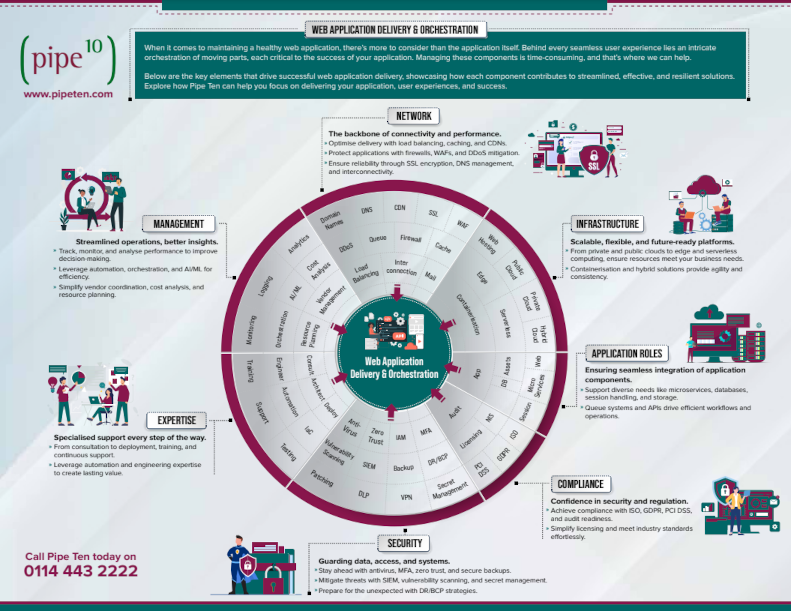Over the past decade or so the banking industry has been coming under mounting pressure to modernise and remove their reliance on increasingly antiquated infrastructure. Whilst reliable it simply isn’t equipped to keep up with the demands of digital transformation that is driven by the evolving convenience expected by consumers, increasing pressure from new competition in the form of Neobanks or Challenger Banks and regulatory changes. 
Cloud, hybrid cloud and multi-cloud computing structures are able to offer a scalable, cost-effective, and secure alternative to traditional banking infrastructure. However, transitioning this over to the cloud obviously comes with its own set of challenges and strategic considerations.
The Problem with Legacy Banking Infrastructure
Legacy banking infrastructure is traditionally built on mainframes and on-premise data centres. Historically these have proved to be highly stable for decades but come with significant limitations. They can have extremely high maintenance costs when dealing with updates, patches and support for software and hardware that has become outdated. This is compounded by the inability to scale to meet an increased demand of transaction volumes. Legacy systems can be more susceptible to cyber threats, they have a severe lack of agility to respond to new market demands and regulatory changes.
Many traditional bank’s still rely on these systems designed decades ago which make it incredibly difficult to integrate with modern fintech solutions and digital banking platforms, which can be a real issue in this new era of open banking which was initiated in 2018 with the European Union’s introduction of the revised Payment Services Directive (PSD2).
The Need for Cloud Migration in Banking
The demand for digital banking services is growing rapidly, with market projections showing a significant compound annual growth rate (CAGR) of between 3% and 13%. This indicates a consistently increasing adoption of digital banking platforms driven by consumer preference for convenience, and a growing preference for online transactions. This trend is further fuelled by increased smartphone usage and a rising number of digitally-savvy users with younger generations embracing the shift towards digital banking.
There are also regulatory and security requirements that are driving cloud adoption such as data privacy laws like the DPA and the GDPR, healthcare regulations like HIPAA, payment card industry standards (PCI DSS), which all push organisations to adopt cloud services that offer robust data protection, access controls, and security features to meet these stringent compliance standards.
The Benefits of Cloud Adoption in Banking
With cloud adoption comes many benefits for banks, not least through operational efficiency and significant cost reduction. The governor of the Bank of England Andrew Bailey estimates that banks can cut costs by between 30 to 50 percent by moving to the cloud. This is primarily achieved through reduced hardware expenditure, utilising the operational expense (OPEX) model where you only pay for the computing power and storage used, lower maintenance costs with a reduction in staffing levels. The cloud also offers increased flexibility and scalability through the allocation of computing resources based on real-time needs, avoiding overprovisioning and unnecessary costs and the ability to easily scale up or down computing power to meet fluctuating demand without large infrastructure changes.
Challenges in Moving to the Cloud
There are many considerations to take into account for banks when planning their cloud strategy. There is stringent regulatory compliance with regards to things such as data sovereignty where financial institutions store and process customer data in accordance with the General Data Protection Regulation (GDPR) and the Data Protection Act 2018 and the second Payment Services Directive (PSD2), a European Union (EU) law that regulates how payments are made.
The latest guidance from the Financial Conduct Authority (FCA) (within FG16/5 – which outlines regulations for firms outsourcing to the cloud) also strongly encourages financial institutions to carefully assess and manage risks associated with relying on a single cloud provider, effectively pushing towards a multi-cloud approach to mitigate vendor lock-in and ensure resilience by utilising multiple cloud service providers.
Cloud technology also plays a crucial role in implementing ISO 20022 regulations for banks which is a new international standard for financial messages that banks must adopt by November 2025.
There are also numerous security concerns with regards to the prevention of data breaches, malware and ransomware, encryption, insecure access controls, data loss, the identification of vulnerabilities and potential threats and cybersecurity training for employees to name just a few.
The technical complexity of migrating away from traditional mainframes can be significant and engaging with an experienced partner such as Pipe Ten to help design, configure and manage the hybrid or cloud infrastructure can relieve a lot of the stress allowing the development teams to concentrate on the work to refactor and redevelop their applications.
Finally there is also cultural resistance where banks may face resistance for the change due to concerns over job security, training needs, and operational disruptions.
Cloud Migration Strategies for Banks
There are several approaches that banks can take with regards to cloud migration and the choice is dependant on their existing infrastructure and business goals.
Rehosting (“Lift and Shift”) involves moving applications to the cloud with minimal changes and is suitable for banks looking for a quick transition with minimal disruptions, however this may not fully leverage cloud-native capabilities.
Replatforming (“Lift, Tinker, and Shift”) allows developers to make small optimisations while migrating. This can enhance an application’s performance in the new cloud environment while minimising risks.
Refactoring requires applications to be redesigned and redeveloped to be cloud-native. It provides the maximum scalability, flexibility and efficiency but does require significant investment and development resources.
Hybrid cloud seamlessly integrates existing on-premise systems with modern cloud solutions, enabling banks to keep sensitive workloads on-premise while strategically leveraging cloud capabilities in the areas that benefit most.
Phased migration vs. Big Bang approach
Finally, whichever strategy is most appropriate there is the consideration of whether to opt for a phased migration for a gradual transition of systems to minimise simultaneous disruptions or the Big Band approach which involves a complete migration at once which is really only suitable for smaller banks and fintech companies.
Best Practices for a Successful Cloud Migration
The following practices by banks should ensure a smooth transition to the cloud.
Conducting a thorough assessment
Banks should dedicate a significant amount of time identifying which applications should be moved to the cloud and then define a migration roadmap for these.
Selecting the right cloud provider
The primary cloud provider options to consider include AWS, Azure, Google Cloud, and private cloud solutions. Partnering with a cloud agnostic expert such as Pipe Ten, which specialises in orchestrating cloud migrations, is crucial for evaluating each option and make considerations such as security, compliance, and scalability to determine the most suitable solution for an individual organisation’s specific needs.
Implement a strong security framework
Banks must prioritise security at every stage of cloud migration to protect sensitive financial data. Considerations include:
- End-to-end encryption – Make considerations for encrypting data both in transit and at rest to prevent unauthorised access.
- Zero-trust architecture – Verifying every user and device before granting access to any resources.
- Multi-factor authentication (MFA/2FA) – For an extra layer of security beyond single passwords.
- Regular security audits and compliance checks – Ensuring adherence to financial regulations and industry standards.
- Threat detection and monitoring – Using security tools to identify and respond to potential threats in real time.
- Disaster recovery and backup – Implementing failover mechanisms and data redundancy to ensure business continuity.
Ensure seamless data migration Banks need to be meticulous in their planning to avoid and data loss and ensure system interoperability.
Invest in staff training Is is imperative to equip employees with the necessary cloud skills to be able to work with the new cloud systems.
Real-World Examples
Pipe Ten has extensive experience of supporting major UK banks and fintech companies in the migration of traditional financial infrastructure to secure and scalable cloud environments. Drawing on their expertise of working with AWS, Azure, and hybrid cloud solutions, Pipe Ten has ensured an informed approach is taken to moving to the most appropriate infrastructure for a financial organisation, their applications and their customers. Whether it is helping choose the best solution for secret management, helping with Resource Locks in Azure or looking at the different options for using SQL Server in the cloud or configuring Always On Availability Groups, these are completed with considerations for regulatory compliance, employing security-first methodologies, and strategically phased adoptions that enable seamless transitions and minimising the risk for operational disruption.
Future of Cloud-Based Banking
The future of cloud adoption in banking is definitely looking promising, with emerging technologies further enhancing its capabilities such as AI and Machine Learning particularly in areas such as using analytics for fraud detection, risk management and personalised banking experiences, blockchain integration for secure, decentralised transaction processing and the expansion of Open Banking and other API driven eco systems for seamless integration with fintech solutions.
Conclusion
The migration of legacy banking infrastructure to the cloud is no longer a question of if, but when and how. With growing regulatory demands, evolving customer expectations, and pressure from fintech disruptors, banks must adopt cloud solutions to ensure scalability, security, and cost efficiency.
However, successful cloud migrations requires careful planning and execution. Whether through a hybrid, multi-cloud, or fully cloud-native approach, working with experienced partners such as Pipe Ten can significantly ease the transition and ensure a secure, compliant, and future-proof infrastructure. With a deep understanding of financial infrastructure, Pipe Ten has helped major UK banks and fintech companies transition to secure and scalable cloud environments.
At the end of the day, moving to the cloud is not just about technology, it is about future proofing banking operations as the financial landscape rapidly evolves. By adopting a structured migration approach and working with trusted cloud experts like Pipe Ten, banks can successfully navigate this transition while maintaining security, compliance, and operational excellence.
Author: Gavin Kimpton
A founder of Pipe Ten, Gavin has been a leader in the digital sector for over 30 years, specialising in website hosting, domain registration, and international site launches. He has navigated evolving internet governance, from new top-level domains to security and compliance. Under his leadership, Pipe Ten became a Nominet-accredited channel partner, reflecting his deep expertise in the digital ecosystem.

